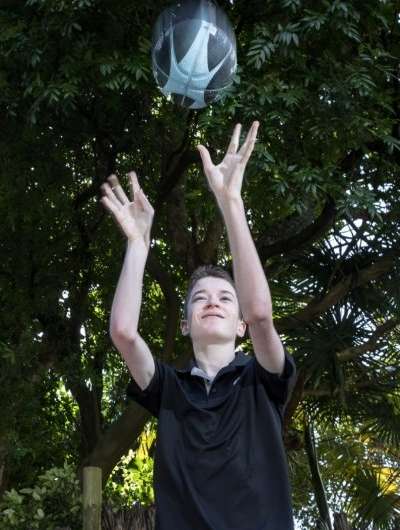Vibration therapy trialled in young children

The Torrens Kelly family were "somewhat sceptical" when son Luke, then 12, joined a clinical trial of a new vibration therapy for cerebral palsy at the Liggins Institute. "Luke has had many therapies in the past and it is often hard to judge whether or not they have any effect," says his mother, Tracey Torrens.
It turned out that the vibration therapy was fun and easy for Luke, who is at the mild end of the spectrum, and caused him to gain 2kg in muscle mass after five months. "What was really special to see was how he regained confidence in sport and was happy to partake in handball at school this year."
Whole-body vibration training involves standing on a specially designed vibration plate (different from the ones sold in malls for toning). Its see-saw movement stimulates a pattern similar to walking, which is thought to improve communication between the muscles and spine, aiding balance and co-ordination.
Luke was one of 40 people with cerebral palsy, aged 11 to 20, in the trial, which showed vibration therapy increased strength and mobility.
Now the same therapy will be trialled in younger children thanks to a grant of $390,000 over three years from The Jubilee Crippled Children Foundation Trust, which also funded the original research along with the Sir David Levene Foundation.
Researchers aim to recruit 40 children aged five-ten years with mild to severe cerebral palsy and general musculoskeletal disability. They will also investigate the feasibility of using vibration therapy in under-fives at high risk of neuromuscular problems, and the effects of shorter sessions for adolescents.
"Together, these studies will identify who will benefit the most from vibration therapy and what is the best protocol – frequency and duration – according to their health and age," says study lead Dr Silmara Gusso, a Research Fellow at the University of Auckland's Liggins Institute.
"Our hope is that our research will enable practitioners to develop new physical therapy programmes tailored for individual kids and young adults which incorporate vibration therapy alongside other tools, giving these young people the most benefits possible."
In the original trial, which was the biggest and most rigorous of its kind to date, participants stood on the vibration plate for nine minutes a day, four times a week. After 20 weeks of training, they showed clear benefits: increased bone and muscle mass, and improved day-to-day functioning and quality of life, with some parents reporting fewer falls, better mood, boosted confidence, and greater manoeuvrability. Some children walked 30 per cent further in a six-minute walk test – a big difference for them.
The findings, published in 2016, attracted international attention. "I had parents from around the world asking for more details, or saying thank you for doing research in this area, which is quite humbling," says Dr Gusso.
Many asked where to buy the special vibration plate, which costs $5000-$6000.
Waitakere College in West Auckland, one of the high schools involved in the original trial, was so impressed by the benefits they saw in their students, they are now looking at buying one.
"Many of our students in the trial had improved bone density, muscle mass and some impressive improvements in their walking speed, which can make a huge functional difference in their lives as they can better keep up with their peers," says Fleur White, a paediatric physiotherapist at the school.
The research team has since also trialled the therapy in young people with more severe cerebral palsy, and with general musculoskeletal disability, with results due in 2018.
Cerebral palsy, a group of movement disorders, is the most common cause of physical disability in childhood, affecting two in 1000 children. It's caused by abnormal development or damage to parts of the brain that control movement, balance and posture.
Children with the disorders have reduced muscle and bone mass, and muscles that normally work in complementary action will simultaneously go into spasm, making movement difficult, and leading to muscle wasting over time. About half of children have a raised risk of bone fractures, partly because their muscles aren't pulling on their bones in the normal way to promote healthy bone development.
Until now, treatments to relieve the condition's effects have been fairly limited: injection of botox, surgery, passive stretching by physiotherapists and injection of bisphosphonates to increase bone density.
More information: Silmara Gusso et al. Effects of whole-body vibration training on physical function, bone and muscle mass in adolescents and young adults with cerebral palsy, Scientific Reports (2016). DOI: 10.1038/srep22518




















